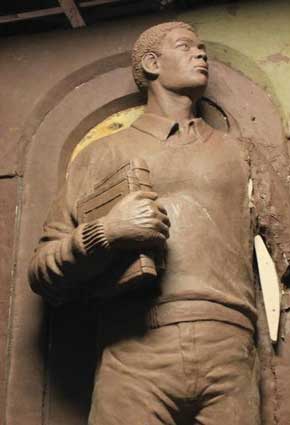Texas Town will unveil statue honoring wrongfully convicted man who died in prison before DNA evidence cleared him of rape
By Frederick H. Lowe -NorthStar News & Analysis | thenorthstarnews.com- | Last updated: Jul 3, 2014 - 8:10:18 PMWhat's your opinion on this article?

Timothy Cole
|
The Timothy Cole Memorial Statue, which was designed by internationally renowned sculptor and Lubbock resident, Eddie Dixon, and paid for by Kevin Glasheen, a Lubbock attorney who has represented 12 wrongfully convicted men, will be unveiled on Sept. 17 in Lubbock, according to the Innocence Project of Texas. The statute faces Texas Tech University Law School. Mr. Cole attended Texas Tech, but he was not a law school student.
The Innocence Project of Texas rescheduled an important luncheon from June 19 in Dallas to Sept. 18 so it could be held in conjunction with the celebration of the statue’s unveiling, the organization wrote in an e-mail to supporters.
The bronze statue will be 10 feet tall and depicts Mr. Cole as a Texas Tech student, carrying a book. The statue is inscribed beneath Mr. Cole’s feet with the phrase “And Justice for All.”
It is believed that this is the first time in the nation’s history that a statue has been erected to honor a man who was wrongfully convicted. Mr. Cole, a U.S. Army veteran, and later a student at Texas Tech, died in prison on Dec. 2, 1999, from respiratory failure brought on by a severe asthma attack, according to the book “A Plea For Justice: The Timothy Cole Story,” which was published in 2010.

|
Mr. Cole, who had spent 14 years in prison before his death, steadfastly maintained his innocence, refusing a chance to be released from prison if he confessed to the crime.
Following his arrest and conviction, local newspapers and television stations dubbed him the “Texas Tech Rapist.”
Police arrested Mr. Cole and a judge sentenced him to 25 years in prison for the rape of Michele Mallin, who was assaulted in the school’s parking lot. There had been a series of rapes on the Texas Tech campuses, and an undercover Lubbock police woman declared Mr. Cole was the rapist.
The local papers printed headlines, “ That’s him,” “Jury indicts Tech student,” and “Texas Rapist Convicted.” The newspaper headlines were very similar to some headlines New York City papers printed following the arrests and convictions of the Central Park Five.
The perpetrator sparks a re-investigation of the crime, not the police
And like the Central Park Five case, it wasn’t the police who sparked a reinvestigation of the high-profile crime; it was the actual perpetrator. In the case of the Central Park Five, it was the confession of Matias Reyes, a serial rapist, that led to re-investigation of the attack on Trisha Melli, which occurred on April 19, 1989, in New York’s Central Park.
Jerry Wayne Johnson, an inmate and serial rapist housed in the Texas Department of Corrections, confessed in a petition on Feb. 3, 1995, to the Lubbock District Attorney that he raped Ms. Mallin, but his petition was blocked and ignored.
The Innocence Project of Texas began investigating Mr. Cole’s case in 2007 when Ruby Cole Session, Mr. Cole’s mother, received a letter from Mr. Johnson who mailed the letter to Mr. Cole’s last-known address. In the letter, Mr. Johnson admitted to the rape for which Mr. Cole had been charged and convicted, according to “A Plea For Justice: The Timothy Cole Story.”
Some of the letter’s contents
“I have been trying to locate you since 1995 to tell you I wish to confess I did in fact commit the rape Lubbock wrongfully convicted you of,” inmate Johnson wrote to Mr. Cole, not knowing he was dead. “It is very possible that through a written confession from me and DNA testing you can finally have your name cleared of the rape and removed from being a parolee, registered sex offender and to received [sic] compensation for the time you were wrongfully convicted.” The book “A Plea for Justice” published Mr. Johnson’s letter.
More than a year later, DNA evidence linked Mr. Johnson to the rape of Ms. Mallin.
Although Ms. Mallin had picked Mr. Cole’s picture out of a police lineup, she said the man who raped her smoked throughout the crime. Mr. Cole, an asthmatic, did not smoke. Although dead, Mr. Cole was exonerated of the crime.
In 2010, Texas Gov. Rick Perry posthumously pardoned Mr. Cole. As a result, the Texas legislature passed legislation named in Mr. Cole’s honor. The legislation requires the state of Texas to pay $80,000 for every year a wrongfully convicted man or woman spent behind bars.
The statue will be the second time Mr. Cole has been honored. The Texas Historical Commission placed a historical marker in Fort Worth, Texas, near the cemetery where Mr. Cole is buried. It is the first historical marker to honor a person who was wrongfully convicted and later exonerated.
Unlike Donald Trump, who called New York City’s recent $40 million settlement with the Central Park Five for their wrongful convictions a “disgrace,” Mr. Glasheen, a Libertarian Republican, said in a 2009 interview that many people were moved by Timothy Cole’s story. Mr. Glasheen’s law firm Glasheen, Valles and Inderman LLP funded the statute’s construction and installation.
INSIDE STORIES AND REVIEWS
-
-
About Harriett ... and the Negro Hollywood Road Show
By Rabiah Muhammad, Guest Columnist » Full Story -
Skepticism greets Jay-Z, NFL talk of inspiring change
By Bryan 18X Crawford and Richard B. Muhammad The Final Call Newspaper @TheFinalCall » Full Story -
The painful problem of Black girls and suicide
By Charlene Muhammad -National Correspondent- » Full Story -
Exploitation of Innocence - Report: Perceptions, policies hurting Black girls
By Charlene Muhammad -National Correspondent- » Full Story -
Big Ballin: Big ideas fuel a father’s Big Baller Brand and brash business sense
By Bryan Crawford -Contributing Writer- » Full Story






 Click Here Stay Connected!
Click Here Stay Connected!








